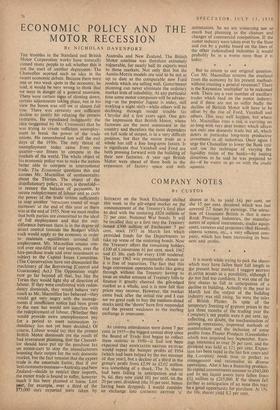COMPANY NOTES
BY CUSTOS INTEREST on the Stock Exchange shifted thiS week to the gilt-edged market on the announcement of the Treasury's final plan to deal with the maturing £824 million of 21 per cent. National War bonds. It will he recalled that as a first step the Treasury issued £300 million of Exchequer 5 per cent. stock 1957 in March last which provided funds for the Departments to take up some of the maturing bonds. Now the Treasury offers the remaining holders £100 of Conversion 41 per cent. stock 1962 and £1 10s. cash for every £100 tendered. The year 1962 was presumably chosen as it is free of maturities. The fact that this huge conversion operation looks like going through without the Treasury having to issue an undue amount of Treasury bills to finance it greatly cheered the gilt-edged market as a whole, and it is now felt that prices may recover. However, the market came back after the initial rise and I can see no great rush to buy the medium-dated stocks until the 'shorts' have first responded and the present weakness in the sterling exchange is overcome.
As cinema attendances were down 7 per cent. in 1955—the biggest annual drop since the Board of Trade first began to collect these statistic in 1950—it had not been expected that ASSOCIATED BRITISH PICTURE, would repeat the bumper profits of 1954 (which had been helped by the wet summer of that year), but a decline of a third in the group's profit from £2.99 to £2.02 million was something of a shock. The 5s. shares had been falling in anticipation and at 9s. 6d. they now yield 101 per cent, on the 20 per cent. dividend (the 10 per cent, bonus having been dropped). I would consider an exchange into GAUMONT BRITISH 4A.
shares at 5s, to yield 144 per cent, on the 15 per cent, dividend which was last covered 2.7 times by earnings. The attrac- tion of Gaumont British is that it owns Rank Precision Industries, the manufac- turers of optical instruments, studio equip- ment, cameras and projectors (Bell Howell), cipema screens, etc., a very efficient com- pany, which has been increasing its busi- ness and profits.
It is worth while trying to pick the shares which may have fallen their full length in the present bear market. I suggest BRITISH PLASTER BOARD as a possibility, although 1 do not feel too confident. It was one of the first shares to fall in anticipation of a decline in building. Actually in the year to March last the output of the building industry was still rising. So were the sales of British Plaster. In spite of the temporary freezing of gypsum prices in the last three months of the trading year the Company's net profits were 6 per cent, up. reflecting, no doubt, the mechanisation of mining operations, improved methods of manufacture and the inclusion of sonic profits from Plaster Products (Greenhithe) which was acquired last September. Earn- ings amounted to over 26 per cent, and the dividend was held at 121 per cent. Expan- sion has been rapid in the last few years and the Company needs time to perfect its management and rationalise its diverse operations. Also it has a financing probleth. Its capital commitments amount to £945,000 and its net liquid assets have fallen from Ell million to £265,000. If the shares fall further in anticipation of an issue this may be a good opportunity for purchase. At 15s. the 10s, shares yield 8.2 per cent.


































 Previous page
Previous page